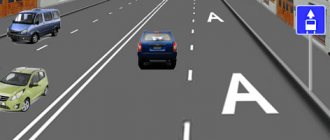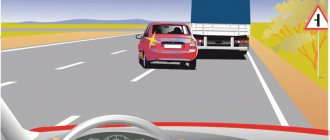It is important for the driver to observe the work and rest schedule (WRO), not only because violations are subject to a fine. The consequences of violations of the regime - overwork and inattention - often lead to accidents on the roads. Izvestia cites the following statistics: more than half of all road accidents are associated with driver fatigue. In this article we will tell you:
- What schedule can a driver work on?
- Driver working time tracking: how many hours a day can he work?
- What is included in a driver's working time?
- What types of driver rest are there?
- What is the difference between the work and rest schedules of bus, truck and taxi drivers?
- Who controls the driver’s work and rest schedule and how?
- Fines for violations of the work and rest regime of drivers
- How to pay a fine for violating the RTO
What schedule can a driver work on?
The driver’s work and rest schedule must be recorded in the Internal Labor Regulations (ILR) of the organization in which he works and specified in the employment contract. The duration of working hours, the number of breaks and days off are regulated by the driver’s schedule. They come in three types:
- Removable. The driver goes to work on his shift - day, evening or night based on the shift schedule that the employer draws up monthly.
- Explosive. A driver's work shift consists of several periods with breaks between them, because the intensity of transportation is uneven throughout the day. This helps avoid overtime. The total duration of working periods fits into the norms of the Labor Code of the Russian Federation. The first break during a discontinuous schedule may occur no earlier than 4 hours from the start of the shift.
- Irregular. The driver is called to work as needed, often outside the established working hours.
Driver working time tracking
The features and duration of working hours for drivers are prescribed in Order of the Ministry of Transport No. 15 “On approval of the Regulations on the peculiarities of working hours and rest time for car drivers.” Depending on the schedule and nature of the work, the organization uses one of two methods for recording the working time of the driver employee.
- Daily. The maximum working time does not exceed 40 hours per week. With a five-day week - 8 hours a day, with a six-day week - 7 hours a day.
- Summarized. Over the course of a day or week, a driver may work more than normal. The main thing is that the total time worked does not exceed the monthly norm. This accounting method is used if, due to the specifics of the work, there is a need to extend the work shift. For example, with an irregular schedule.
With the summarized accounting method, working hours can be increased to 10 hours, but no more than twice a week. The total driving time per week should not exceed 56 hours, and for two consecutive weeks - 90 hours.
In exceptional cases, working hours can be increased to 12 hours for drivers employed in:
- passenger transportation in the city or suburbs,
- transportation over long distances to get to a vacation spot.
Such overtime shall not exceed 4 hours over two consecutive days and 120 hours per year.
If the trip lasts more than 12 hours, two drivers will take over, and the vehicle must be equipped with a place to sleep.
Theory
Studying at a driving school is always based on an educational program developed by the state. We provide all the necessary knowledge and skills to pass the traffic police tests. And the first test is internal exams. They are built on the same principle as tests in the inspection: first theoretical tasks, then practical ones. Graduates demonstrate how well they know the rules of the road, and then proceed directly to driving. Training in a driving school is considered officially completed upon receipt of the appropriate certificate.
Practice: city
At the end of your studies at the driving school, you take internal exams. Teachers test knowledge of traffic rules and other theory, and also organize a practical test. After successful completion, students are sent to the traffic police.
June 18, 2010 N 636 Order of the Ministry of Education and Science of the Russian Federation dated June 18, 2010 N 636 “On approval of Model training programs for drivers of vehicles of various categories” put into effect Model driver training programs that are still in effect today. In the texts of the programs there is no division between astronomical and academic hours, just as there is no such division when studying theory and mastering practice in other educational organizations.
Is the driving school right? Is it true that an hour of driving is a class hour? Is it correct to include travel to and from the race track while driving? Why should the distance from the racing track to the driving school interest me?
Is an hour of driving 60 or 45 minutes? Does it include delivery from the driving school to the racing track?
The contract states “56 hours of practical driving lessons, including exams.” With proper skill, this can be interpreted the way it was explained to me at the driving school (including a trip to the site). That’s why I asked how to understand this in general. This is about practical driving. Is this still driving?
Practical driving standards for students of all categories are legally established. For each, this standard is different due to the specifics of the category received and the purpose of obtaining a driver’s license. The driver's license categories and the corresponding driving training standards are presented in the table below.
What is included in a driver's working time?
In addition to driving the vehicle, the following are taken into account when calculating the driver’s working time:
- Preparation for the flight and final work after returning to the organization. When traveling long distances and intercity transportation, the time spent working at the transit point is additionally taken into account. The composition and duration of these works are established by the employer in agreement with the organization's drivers.
- Pre- and post-trip medical examinations. Their duration is also set by the manager.
- Parking at loading and unloading points and passenger pick-up/drop-off points.
- Scheduled breaks. For example, for a break from driving, for heating when working in low temperatures or for removing heat when working in the heat and other breaks. The driver must take a rest break from driving no later than after the first 4 hours behind the wheel. And in the future - no later than every 2 hours. You need to rest for at least 15 minutes.
- Downtime is not the driver's fault.
- Work to eliminate faults discovered along the way, which do not require disassembling the mechanisms or towing them to a car service center.
- Security of cargo and vehicle while parked at transit points.
- If two drivers are sent on a trip, the time the shift worker spends at the workplace when he is not driving is taken into account.
Some driver activities may not be paid in full. The employer can pay only 50% for the time the second driver spends at the workplace when he is not driving. Time for securing cargo and vehicle by 30%. Moreover, if two drivers go on a trip in one car, then the time for securing the cargo is credited to only one of them. These points must be specified in the employment contract.
An example of calculating a driver’s working time for different types of activities:
| Kind of activity | Actual time | Work time |
| Cargo and vehicle security | 2 hours | 36 minutes (minimum 30%) |
| The second driver was at work, but not driving | 4 hours | 2 hours (minimum 50%) |
| Pre-trip medical examination | 15 minutes | 15 minutes |
| Driving | 4 hours | 4 hours |
| Taking a break from driving | 20 minutes | 20 minutes |
Check the organization's fines
Number of hours depending on the category of rights
When choosing a driving school, you should give preference to those in which the practical part is calculated in astronomical hours, which increases the duration of practical driving, allowing you to more thoroughly acquire knowledge in practice. Any comments from driving school representatives regarding the degree of preparedness for going on the road, expressed with a simultaneous proposal to conduct a lesson on a simulator or race track, should be suppressed, since this reduces the time of practical driving.
Types and features of driving hours
In the first case, 1 academic hour is only 45 minutes, while 1 astronomical hour is 60 minutes. The variety must be indicated both in the contract and in the training program of the selected driving school. If such information is missing, it is worth clarifying further. At the same time, one practical lesson in a driving school is 2 hours. The total number of hours also includes the time of exams at the school itself and the traffic police. The total duration of the exams is 8 hours, which actually shortens the practical course (this is legal). Driving schools follow such a path that part of the practical time, usually 6 hours, is spent not in a training car, but on simulators.
Based on the new rules, driving schools that also train for motorcycle categories will have to acquire their own or rent a platform about 100 meters long, which is unrealistic in big cities. Many motorcycle schools will not be able to get space for such a site.
What types of driver rest are there?
| Type of holiday | Duration |
| Break for rest and food during the working day | From 30 minutes to 2 hours. |
| Daily (between shifts) rest | At least 2 times longer than a work shift. In exceptional cases - at least 9 hours. |
| Weekends (weekly uninterrupted rest) | Minimum 42 hours continuously. |
| Annual leave | Minimum 28 calendar days. |
Let's look at each of them in more detail.
Breaks for rest and food
The break can range from 30 minutes to 2 hours. If a working day (shift) lasts more than 8 hours, then there can be two breaks, but their total duration should also not be less than half an hour or exceed 2 hours.
Daily (between shifts) rest
The duration of such rest, if added to a break for rest and food, should be at least 2 times longer than the working day (shift) preceding it. For example, after an 8-hour work shift, a driver must rest for at least 16 hours before starting the next one.
When calculating working hours in total, daily rest should not be shorter than 12 hours. On regular urban and suburban services it can be reduced to 9 hours. But immediately after the shift, which included such a shortened daily rest, the driver, upon written application, has the right to rest for at least 48 hours. During international transportation, the driver can rest at intermediate stops for at least 11 hours. Read more in paragraph 25 of Order No. 15 of the Ministry of Transport.
In any case, the driver’s daily rest from driving must be continuous.
Weekly uninterrupted rest (weekends)
With a five-day week there are two days off, with a six-day week - one. The total duration of a driver's weekly uninterrupted rest should not be less than 42 hours. This is stated in paragraph 26 of Order No. 15 of the Ministry of Transport.
When recording working hours together, weekends can be set on different days of the week each time according to shift schedules. In this case, there must be no less weekends in the current month than full weeks of the same month.
Drivers may be hired to work on non-working holidays if the specifics of their work are related to:
- activities, the suspension of which is impossible due to production and technical conditions;
- public service;
- repair and loading and unloading operations.
Other cases and conditions for attracting employees to work on weekends and holidays are described in Article 113 of the Labor Code of the Russian Federation.
Annual leave
Drivers, like employees of other specialties in Russia, are provided with an annual basic paid leave of 28 calendar days.
For drivers with irregular working hours, additional paid leave is provided for a period of at least 3 days. Its specific duration is determined by the regulatory documents of the organization, PVTR or collective agreement.
Harmful or dangerous working conditions are also subject to additional leave of at least 7 days. Work is recognized as dangerous or harmful based on the results of a special inspection. In any case, this must be specified in the employment contract.
More details about the conditions and terms of vacations can be found in Chapter 19 of the Labor Code of the Russian Federation.
Fines for legal entities
Check
What is the difference between the work and rest schedules of bus, truck and taxi drivers?
Work and rest schedule of a taxi driver
It is not much different from the conditions described above. Taxi driver working hours include:
- medical examinations before and after the flight;
- time to receive the car and return it after the shift;
- direct driving;
- easy to wait for orders;
- eliminating breakdowns and malfunctions along the way, such as topping up the washer fluid, changing a wheel, and others, if they do not require disassembling the mechanisms or towing to a car service center;
- rest breaks from driving;
- car wash, if required.
Taxi drivers cannot have irregular working hours.
Non-working time of a taxi driver is:
- Break for meals and rest. It is usually placed mid-shift and should last between 30 minutes and 2 hours.
- Daily (between shifts) rest. The duration should be at least twice as long as a work shift.
- Weekend. With a five-day working week there should be 2, with a six-day week - one. The specific days of the week that are days off for a taxi driver may vary.
Otherwise, the types of recreation for a taxi driver are the same as those described above.
Work and rest schedule for bus and truck drivers
For drivers of buses and trucks with a maximum permissible weight of more than 3.5 tons, the work and rest regime is prescribed separately in paragraph 26 of the Traffic Regulations of the Russian Federation. They should not spend more than 9 hours a day driving. Although it is possible to increase this time to 10 hours, but no more than twice during a calendar week. At the same time, no more than 56 hours behind the wheel should accumulate in one week, and no more than 90 hours in two weeks in a row.
A bus or truck driver can drive a vehicle for no more than 4.5 hours without a break. Afterwards he must take a break for at least 45 minutes. The break can be divided into two or more parts by other activities. In this case, the first part of the rest should last at least 15 minutes, and the last - immediately before returning to the wheel - at least 30 minutes.
When working in mountainous areas, driving time should not exceed 8 hours for drivers:
- buses longer than 9.5 meters;
- trucks with heavy, long and large cargo.
A driver's working day on regular city and suburban bus routes can be divided into two parts by a break. The break must begin no later than the first five hours worked. Usually the duration of the break cannot be more than 2 hours, but with the consent of the driver it can be increased to 3 hours.
Moreover, if such a break is set at least after four hours from the start of the working day, then before it occurs, the driver is given special breaks to rest from driving the bus. Their duration must be at least 15 minutes.
The break between parts of the shift does not count towards working hours and does not include a lunch break. The driver can use it at his discretion
Whatever the duration of the breaks, the total duration of the bus driver’s shift must fall within the standards described above in the article.
Checking fines for legal entities. persons
Monitor fines, receive a daily report on new found fines and pay them automatically
Try for free
Who controls the driver’s work and rest schedule and how?
The employer is obliged to monitor compliance with the work and rest schedule of drivers. All legal entities and individual entrepreneurs whose activities are related to the operation of vehicles must equip them with tachographs. Read more about which cars must have tachographs installed in our article.
A specially appointed specialist is responsible for working with tachographs in the organization. If this is not the case, then the responsibility falls on the manager. The driver must know how to use the tachograph, monitor its performance on the road and have instructions.
If the tachograph fails on the way, the driver must begin to record the work and rest schedule manually: fill out a table on the thermal paper of the tachograph or draw it on any sheet of paper.
Using approximately this form, the driver can manually register his work and rest schedule.
With a broken tachograph, the driver can only continue driving towards the nearest service station or parking lot. The journey from the moment the device breaks down should not take more than 7 days. A list of workshops for the repair and maintenance of tachographs in the regions of Russia is on the Rosavtotrans website.
Traffic police and Rostransnadzor employees can check whether the car has a tachograph and its serviceability. There are fines for a faulty tachograph or its absence.
Types of cards used with a tachograph
The driver’s personal card is a kind of key to the device for monitoring and recording data on speed limits and RTO. There are 2 types of driver cards: those that work with CIPF tachographs (they are installed on cars operating domestic commercial flights) and AETR cards that are compatible with European-style devices that are equipped in cars for traveling abroad. Regardless of the type of card, there is an electronic chip inside it, which duplicates the information recorded by the recorder, and also stores the driver’s personal data.
In addition to driver cards, there are several other types of cards used with a tachograph:
- for controllers – needed during inspections;
- card service. centers. They allow you to legally interfere with the operation of the device - perform repairs, calibration, etc.;
- enterprise cards - provide access to data stored in the tachograph memory, their analysis and decryption.
Fines for violations of the work and rest regime of drivers
The most common violations of the work and rest schedule of drivers are:
- the time limit for driving a vehicle has been exceeded;
- the standard working time for cumulative accounting has been exceeded;
- the driver is sent on a long trip without a replacement, especially at night;
- the manager did not draw up a work schedule for the driver.
Part 3 of Article 11.23. The Code of the Russian Federation on Administrative Offenses provides for the following fines for violating the work and rest schedule of drivers, namely for non-compliance with the norms of driving time and rest time:
- for the driver - from 1,500 to 2,000 rubles;
- for an official - from 7,000 to 10,000 rubles;
- for an individual entrepreneur - from 15,000 to 25,000 rubles;
- for a legal entity - from 20,000 to 50,000 rubles.
Check your organization's fines now
How to pay a fine for violating the driver’s work and rest schedule
It is not possible to pay a fine for violating the work and rest schedule with a 50% discount. This is not provided for by law. Therefore, it is important to prevent violations in order to avoid paying large fines.
You can find and pay a fine for violating the driver’s work and rest schedule on the websites of the State Traffic Safety Inspectorate, Rostransnadzor and the State Services portal. But if an organization has a large fleet of vehicles and a staff of drivers, you can find and pay all fines faster in the Online State Traffic Safety Inspectorate service: you don’t have to check each car and driver manually. The check is carried out automatically using the federal treasury database, which contains information on all fines of legal entities and individuals.
The service monitors the appearance of new car fines for the organization, notifies about them and payment deadlines in your personal account or via SMS.
according to article
Write to our lawyer and he will help you understand automobile legislation. We will consider controversial situations and tell you how to act according to the law.
Don't miss new useful publications
We will tell you about the intricacies of the legislation, help you understand it and tell you what to do in controversial situations.
The ratio of classes on the site and in the city according to the program
In 2021, the Ministry of Education and Science “recommended” to increase the duration of the practical module from 30 to 50 hours. However, the number on paper and the total duration of lessons in reality may differ in value. How does this happen? Let's take a closer look.
The traffic police will begin to interact with driving schools in a new way in 2021
— Evgeniy Zubik, head of the Ostrogozh training center;— Ruslan Minkov, deputy head of the center for educational work;— Dmitry Mikhailov, senior assistant to the head of the training department;— Sergey Telykh, driving instructor;— Alexander Kirillov, driving instructor;— Maxim Panshin, driving instructor.
Since the cost of training depends on the number of hours, carefully also look at what hours the driving school offers you. There are academic clocks, forty-five minutes each, and astronomical ones, sixty minutes each. When you enter into an agreement with a driving school, do not forget to make sure that it indicates both the number of hours and the number of minutes in these hours.
You might be interested ==> What is required for large families in the Stavropol Territory with five children?
As Nikolai Gilyakov, head of the traffic police examination department, said, only half of the future drivers managed to pass all the exams the first time this year. And 17 percent of driving school graduates were forced to take retakes more than three times. At the same time, the main stumbling block for potential motorists was and remains the exam in the city. Both last year and this year, only a third of candidates coped with it on the first try. But, as the department notes, the accident rate involving newcomers has decreased by half over the past five years.
In 2021, drivers will be tested without a “platform”
If the documents have been collected correctly and sent to the examination department, then the person is allowed to take the first part of the exam. It consists of testing theoretical knowledge of traffic rules. At this stage in 2021, some innovations have been introduced.
Despite any crises, many Russians can afford to own personal vehicles. The demand for new and used cars on the market, although it has decreased, has not completely disappeared and cannot disappear. So is the demand for driving school services. Someone goes to study for a license, reaching the minimum age at which this is generally possible. Some are older and more advanced in age, planning to buy their own car. How long it takes to study for a license in 2021 is one of the most popular questions that future cadets of driving schools in Russia have.










